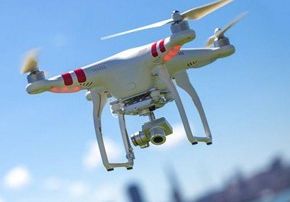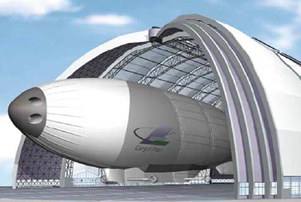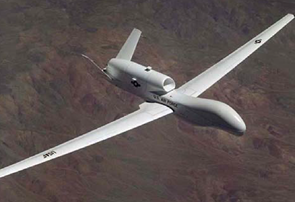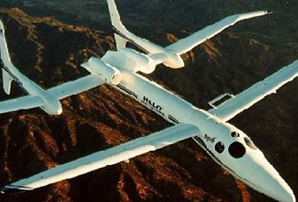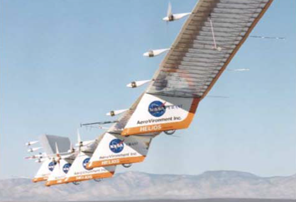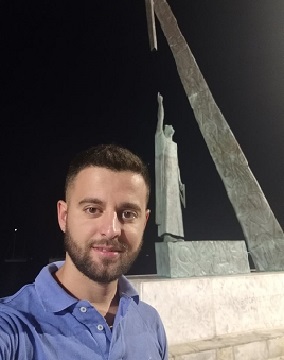Project Description
Non Terrestrial Networks
In beyond fifth-generation (B5G) applications, the effective wireless connectivity is not only requisite for the data transmission between multiple nodes, but also represents a key factor to ensure the safety of personnel or citizens in remote locations, especially in cases with environmental hazards or in emergency situations. However, a huge number of base stations is indispensable for global radio coverage. In addition, the terrestrial communication infrastructure is sensitive to natural disasters, e.g., earthquakes and floods. To further extend the wireless connectivity into remote and inaccessible areas and also enhance the reliability and resiliency of services, the non-terrestrial communications infrastructure should be leveraged. The non-terrestrial networks (NTNs) are capable of simultaneously interconnecting a massive number of devices that struggle for connectivity, while ensuring the successful management of data-intensive applications, redundant connections at critical sites, low latency, and enhanced capacity. In addition, NTNs can ensure the delivery of wireless services in challenging environments with highly mobile and dispersed nodes by exploiting network segments in space, air, and ground.
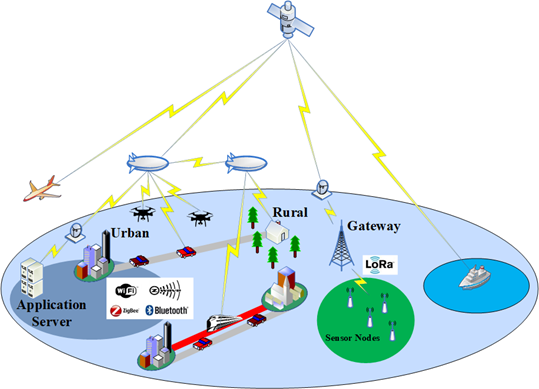
Aerial Communications
Beyond satellites, NTNs indicate networks or segments of networks with high- and low-altitude platforms (HAPs/LAPs) or airborne vehicles acting as aerial transceivers that operate at altitudes ranging between 8 and 50km above ground level. The term HAP defines both aircrafts flying in a roughly circular tight path in the stratosphere layer and quasi-stationary, solar-powered, non-pollutant, and environmentally friendly airships. Besides, LAPs fly at lower altitudes, in the troposphere, and intend to accomplish diverse missions. Among them, unmanned aerial vehicles (UAVs) constitute a type of small fueled aircraft employed for short time periods and allow for a rapid relay-based deployment of a multi-hop communication backbone. Indicative types of UAVs are drones, remotely piloted vehicles (RPVs), pilotless aircrafts, and robot planes. Since the links of terrestrial systems are often blocked, aerial platforms have great potential to attain a higher chance of line-of-sight (LoS) communication with the ground users and thus enhance the coverage and connectivity. B5G and Internet of Things (IoT) systems are expected to include aerial platforms as autonomous communicating nodes or aerial relays for attaining highly reliable connections between sensors and data collection points at high elevation angles and across urban, suburban, and rural terrains. Both HAPs and LAPs can be rapidly deployed and moved on-demand and can also carry a range of sensors, including geospatial sensor technologies gathering massive amounts of valuable data.
Aerial Platforms and Aerial Vehicles
Our research is focused on the analysis and design of new techniques for aerial communications across different network layers for enabling the B5G vision in many practical scenarios and in an energy-efficient, and secure manner. More specifically, we deal with the following fields of research for aerial communications:
- Channel modeling and statistical characterization of air-to-air (A2A) and air-to-ground (A2G) channels
- Development of aerial channel simulators
- Wireless communication technologies, e.g., mmWave, massive multiple input multiple output (MIMO), non-orthogonal multiple access (NOMA), free-space optical (FSO)
- Mobile Edge Computing (MEC)-enabled aerial network architectures
- Energy harvesting and wireless-powered communications
- Reconfigurable Intelligent Surface (RIS)-enabled aerial networks
- Software-defined radio (SDR), software-defined networking (SDN), and network function virtualization (NFV)
- Machine learning (ML) techniques for optimized performance of aerial networks
- Measurements and experimental demonstration for the A2G and A2A channels in various propagation environments
- Development of software-based and hardware-based security solutions for aerial networks
–
–
–
- L. Tsipi, M. Karavolos, D. Vouyioukas, An Unsupervised Machine Learning Approach for UAV-Aided Offloading of 5G Cellular Networks, Telecom, Vol. 3, pp. 86-102, 2022, MDPI, https://doi.org/10.3390/telecom3010005.
- E. T. Michailidis and D. Vouyioukas, “A Review on Software-Based and Hardware-Based Authentication Mechanisms for the Internet of Drones,” Drones, Special Issue on Security, Privacy and Reliability of Drone Communications for beyond 5G Networks, vol. 6, no. 2, p. 41, Feb. 2022.
- E. T. Michailidis, P. S. Bithas, N. Nomikos, D. Vouyioukas, and A. G. Kanatas, “Outage Probability Analysis in Multi-User FSO/RF and UAV-enabled MIMO Communication Networks,” Physical Communication, vol. 49, Dec. 2021, 101475.
- N. Nomikos, E. T. Michailidis, P. Trakadas, D. Vouyioukas, H. Karl, J. Martrat, T. Zahariadis, K. Papadopoulos, and S. Voliotis, “A UAV-Based Moving 5G RAN for Massive Connectivity of Mobile Users and IoT Devices,” Vehicular Communications, vol. 25, 2020, 100250.
- E. T. Michailidis, N. Nomikos, P. S. Bithas, D. Vouyioukas, and A. G. Kanatas, “Optimal 3-D Aerial Relay Placement for Multi-User MIMO Communications,” IEEE Transactions on Aerospace and Electronic Systems, vol. 55, no. 6, pp. 3218-3229, Dec. 2019.
- E. T. Michailidis, P. S. Bithas, N. Nomikos, D. Vouyioukas, and A. G. Kanatas, “A Survey on Machine-Learning Techniques for UAV-Based Communications,” Sensors, vol. 19, no. 23, p. 5170, Nov. 2019.
Research Team
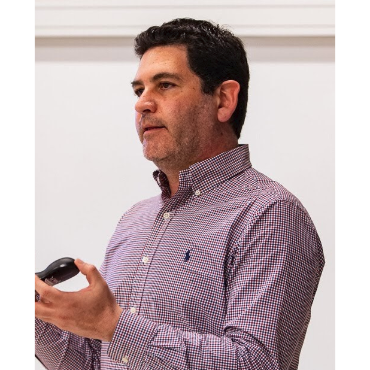
Demosthenes Vouyioukas
DIRECTOR – PROFESSOR
Mobile and Satellite Communication Systems
Dr Demosthenes Vouyioukas received the five-year Diploma in Electrical and Computer Engineering from the National Technical University of Athens (NTUA), and the Ph.D. degree in Electrical and Computer Engineering from NTUA, in 1996 and 2003 respectively. He has also received a Joint Engineering-Economics M.Sc. from NTUA. From 1996 to 2003 he has been a scientific researcher, and from 2003 to 2005 he was a senior researcher at the Mobile Radiocommunications Laboratory of NTUA, where he has been engaged to several European and National Projects. From 2005 to 2006, he was with the Hellenic Aerospace Industry at the Department of Satellite Communications. Ηe is currently Professor and Director of the Computer and Communication Systems Laboratory in the Department of Information and Communication Systems Engineering, University of the Aegean, Greece, where he served as an adjunct lecturer (2004-2010), an Assistant Professor (2010-2016) and an Associate Professor (2016-2020). He also serves as a scientific coordinator in several R&D projects.

Emmanouel Michailidis
RESEARCH ASSOCIATE
Terrestrial, Aerial, and Satellite Comms.
Emmanouel T. Michailidis received the M.Sc. degree in Digital Communications and Networks in 2006 from the University of Piraeus, Piraeus, Greece, and the Ph.D. degree in Broadband Aerospace Communications in 2011 from the University of Piraeus. Since 2021, he has been a Post-Doctoral researcher at the Department of Information and Communication Systems Engineering, School of Engineering, University of the Aegean, Samos Island, Greece. From 2012 to 2021, he was a Post-Doctoral Researcher at the Telecommunication Systems Laboratory (TSL), Department of Digital Systems, University of Piraeus.
Since 2019, he has been an Invited Lecturer at the Department of Information and Communication Systems Engineering, School of Engineering, University of the Aegean, Samos Island, Greece. Since 2018, he has been an Adjunct Lecturer at the Department of Informatics and Computer Engineering and the Department of Electrical and Electronics Engineering, Faculty of Engineering, University of West Attica, Aigaleo/Athens, Greece. From 2007 to 2018, he was an Adjunct Lecturer at the Department of Electronics Engineering, Piraeus University of Applied Sciences (TEI of Piraeus). From 2017 to 2018, he was an Adjunct Lecturer at the Department of Computer Systems Engineering, Piraeus University of Applied Sciences. From 2016 to 2017, he was an Adjunct Lecturer at the Department of Digital Systems, University of Piraeus.
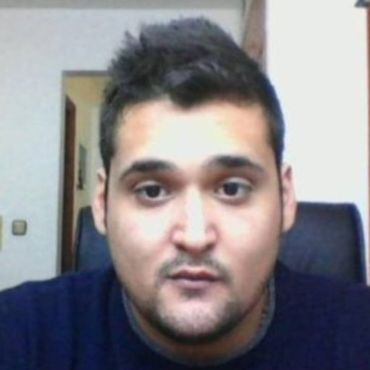
Michail Karavolos
RESEARCH ASSOCIATE
Terrestrial/Satellite 5G Networks
Michail Karavolos was born in Athens, Greece in 1993. He received his Diploma from the Department of Information and Communication Systems Engineering, Technical School of the University of the Aegean in 2017. As an undergraduate student, he received awards for excellent grades, by the State Scholarships Foundation of Greece. Also, he involved in Robotics, Algorithms, Network Security, Software Design and Digital Systems Design with special emphasis on Mobile and Satellite Communications during his undergraduate studies. He was a member of the Robotics team of the University of the Aegean and he has participated in the International Robotics Competition held in Istanbul, Turkey in April 2014, 8th ITU Robot Olympics (ITURO2014). In addition, he participated in the research program Thales of the University of Patras entitled “Algorithmic Game Theory”. He has also worked in projects like website construction (Web Development) and Database Design on behalf of International Society. Furthermore, he has been involved in the design and construction of the UOA/Mythpelsat satellite and is still an active member of the UOA/Mythpelsat team. Currently, he is a PhD Candidate at the Computer and Communication Systems Laboratory (CCSL) of the Department of Information and Communication Systems Engineering of the University of the Aegean. His research interests are in the field of Satellite and Mobile Communications (5G, LTE).


